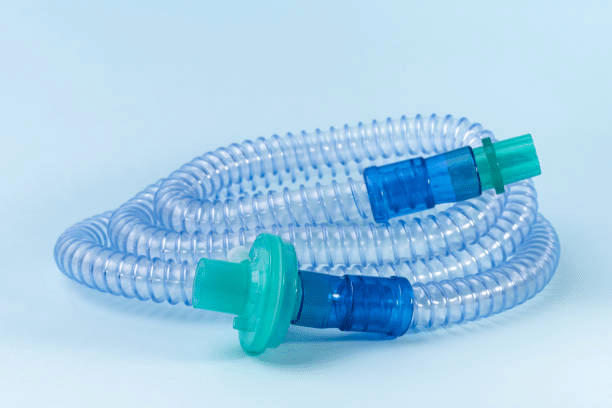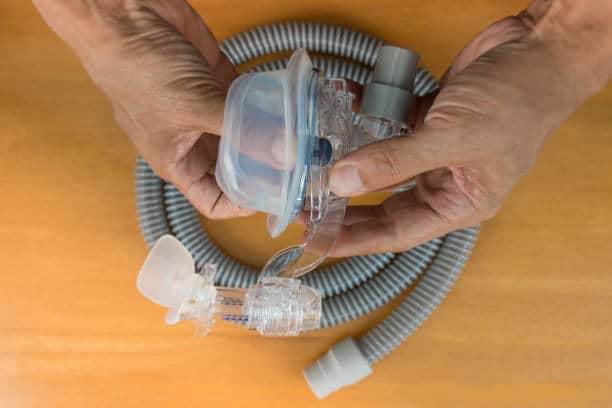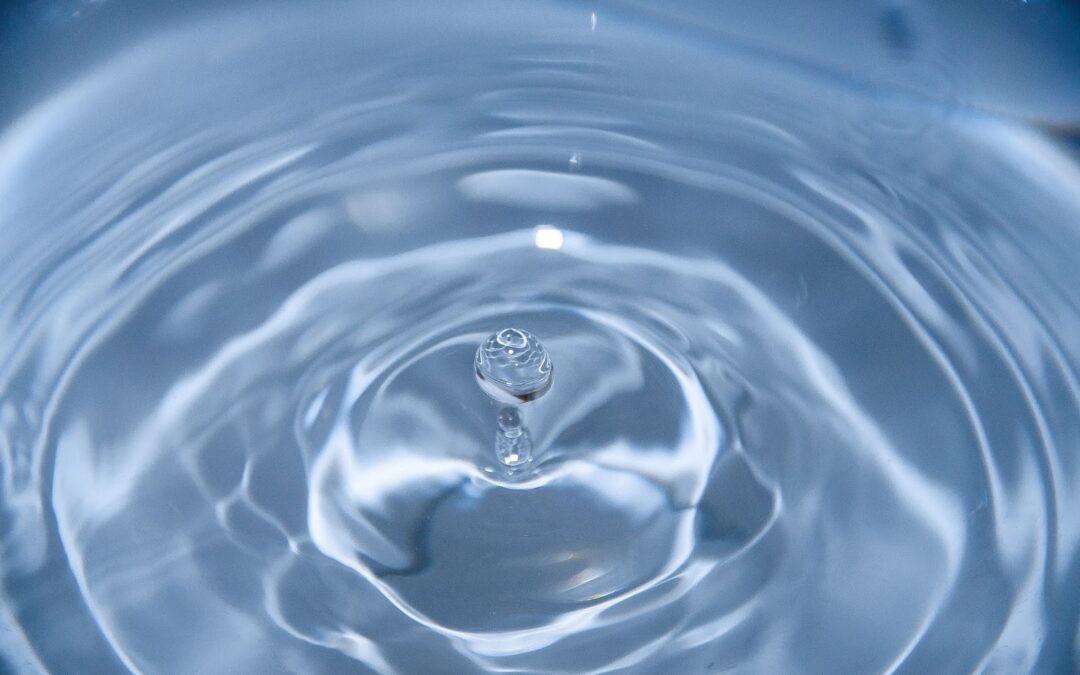Many CPAP users, particularly those utilizing humidifiers or heated tubing to manage dry airways during sleep therapy, often encounter the issue of water in the CPAP hose. This phenomenon, known as “rainout,” occurs when moisture condenses inside the hose, leading to water accumulation. If not addressed, this can lead to discomfort and diminish the effectiveness of CPAP therapy, potentially causing coughing, air leakage, and breathing difficulties.
Understanding the causes of water accumulation in CPAP hoses and implementing proper measures to control it is crucial for maintaining effective sleep apnea treatment. Read until the end to learn more.
Causes Of Water Buildup In CPAP Hoses

CPAP machines provide continuous positive airway pressure treatment for people with sleep apnea. Water accumulation in CPAP hoses is a typical issue that many CPAP users may encounter. This is brought on by the condensation of humidified air, which may make CPAP users uncomfortable and potentially reduce the therapy’s effectiveness.
The temperature of the air, humidity levels, and CPAP machine design are just a few factors that might cause water to build up in hoses. The heated air from the CPAP humidifier cools as it passes through the CPAP tube, forming water droplets that collect in the hose. This is referred to as a “CPAP rainout” informally.
Users of CPAP devices may experience gurgling sounds, leaks, and bacterial development due to water accumulation in CPAP hoses. These side effects may make the user uncomfortable and reduce compliance with CPAP treatment.
CPAP users may experiment with heated tubing, changing the humidity settings on their CPAP machine, and utilizing a hose cover or wrap to minimize water accumulation in hoses. By keeping the air at a consistent temperature, heated tubing prevents condensation from developing. Manage humidification levels by adjusting the humidity settings to avoid too much moisture accumulating in the hose.
Users of CPAP may address the problem and avoid water accumulation by employing a hose holder or tube cleaning equipment to drain water from the hose. To prevent problems like water logging and bacterial development, it’s also critical to routinely clean and repair CPAP equipment.
For the best results with CPAP treatment, controlling water accumulation in hoses is critical. CPAP users may take preventative measures and cope with this frequent problem by being aware of the causes and consequences of water accumulation.
Effects of Water in the CPAP Hose
The accumulation of water in CPAP hoses may have significant consequences on the comfort and adherence of CPAP users. This includes gurgling sounds, leaks, and the development of microorganisms.
- Gurgling noises: One of the most frequent consequences of water accumulation in CPAP hoses. These sounds may be loud and disturbing, preventing the user from sleeping and creating pain. The sound of water sloshing about in the hose may also be unsettling, giving the user worry and tension.
- Leaks: Water accumulation in the hose could cause the CPAP machine to malfunction. This may result in diminished therapeutic effectiveness and cause the user to awaken due to a lack of air pressure. Water and electricity do not mix well, making leaks a potential safety problem.
- Bacterial expansion: Clogging is another detrimental impact of water accumulation in CPAP hoses. The hose’s damp and warm climate is an excellent breeding place for germs and fungi. This may lead to respiratory infections and other health problems, particularly for those with weakened immune systems.
Many of these adverse effects might cause pain and reduce CPAP treatment adherence. The presence of gurgling sounds, leaks, or bacterial development may discourage users from continuing to use their CPAP machine. This might result in a lack of therapeutic adherence, which can have severe health effects.
To counteract these adverse consequences, CPAP users must regulate water accumulation in their hoses.
Examples include:
- Heated tubing
- Adjusting humidity settings
- Using hose covers or wraps
Moreover, regular cleaning and maintenance of CPAP equipment are required to avoid bacterial development and other problems.
By knowing the negative impacts of water accumulation in CPAP hoses, CPAP users may take preventative measures to avoid these concerns and ensure appropriate treatment.
Preventing Water Buildup In CPAP Hoses

The accumulation of water in CPAP hoses may lead to gurgling sounds, leaks, and bacterial development for CPAP users. There are numerous techniques to avoid water accumulation in CPAP hoses.
Here are some considerations:
Employ Heated Hose
Heated CPAP hoses are meant to avoid water accumulation. They function by warming the air inside the hose, which reduces the likelihood of water condensation. There are several kinds of heated hoses, including standalone heated hoses, and hoses that include heated tube kits. Contact your CPAP machine’s equipment vendor for optimal selection.
Change Humidity Settings
Humidified air might lead to water accumulation in CPAP hoses. Thus, it is crucial to modify the humidity settings on your CPAP machine to minimize water accumulation. Contact the manufacturer of your CPAP device for assistance with the optimal humidity levels for your machine and environment.
Utilize Hose Cover
The design of hose covers stabilizes the air temperature inside the hose, preventing water condensation. They function by isolating the hose from the surrounding environment, keeping the air within the hose heated. There are several materials for hose covers, including fleece and neoprene.
Maintain The CPAP Machine At The Appropriate Level
Maintaining the optimum level of your CPAP machine may also avoid water accumulation in the CPAP hoses. Ideally, the machine should be situated at a lower level than the bed. This may prevent water from reentering the hose and device.
Ensuring the Room’s Temperature Is Not Very Cool
The fast heated air cooling in a hose caused by cold temperatures might result in water condensation. Adjust the thermostat or use a space heater to ensure that the room temperature is not too low.
Automatic Tubing Temperature Control For Optimal Humidity Levels
There is also equipment that automatically adjusts CPAP tubing temperature to maintain the desired humidity level. One example is ResMed’s Climate Control, which continuously analyzes the air temperature in your mask and how it is impacted by ambient temperature and humidity. According to studies, up to 70% of CPAP users suffer from nasal congestion, dry nose, and throat, sore throat, nose bleeds (epistaxis), or discomfort due to the cold airflow CPAP.
As necessary, it concurrently adjusts the heated humidifier and tubing levels to maintain a steady humidity level. The S9TM and Air Solutions CPAP machines are equipped with this technology.
Heated hoses are an efficient means of preventing water accumulation in CPAP hoses. They supply the user with warm air, which minimizes the likelihood of water condensation. There are several kinds of heated hoses, including standalone heated hoses, and hoses that include heated tubing kits. Contact your CPAP machine’s equipment vendor for advice on the optimal configuration.
The prevention of water accumulation in CPAP hoses is crucial for the comfort and efficacy of CPAP therapy. By utilizing a heated hose, modifying humidity settings, using a hose cover, maintaining the CPAP machine at the proper level, and ensuring that the room temperature is not too cold, you may avoid water accumulation and have a pleasant experience with sleep apnea treatment.
Dealing with Water in the CPAP Hose
The accumulation of water in CPAP hoses may result in various difficulties, including gurgling sounds and bacterial development.
Here are some suggestions for managing water accumulation in CPAP hoses:
1. Use a Hose Hanger.
A hose holder may assist in keeping the hose high and preventing water accumulation. Also, it prevents the hose from sliding or moving around throughout the night.
2. Use A Tube Cleaning Method.
Several tube cleaning technologies are available for removing water accumulation and preventing bacterial development. Typically, these systems employ cleaning chemicals and drying techniques to maintain a clean and dry hose.
3. Wipe The Hose Down.
If you see water accumulation in the hose, you may eliminate excess moisture by wiping it off with a clean cloth. This will assist in preventing bacterial development and maintain the cleanliness of the hose.
4. Use A Blow Dryer.
If the hose is damp, a hairdryer on a low setting may dry it. Ensure that the hair dryer is held at a safe distance to avoid hose damage.
5. CPAP Mask Adjustment.
You may tighten the mask straps or reposition the mask to prevent water from entering if water is entering the show.
In addition to these solutions, the following are other suggestions for dealing with water accumulation in CPAP hoses:
6. Employ Heated Hose.
A heated hose helps avoid water accumulation by keeping the air warm and reducing condensation.
7. Change Humidity Settings.
Adjust the humidity settings on your CPAP machine if you have water accumulation. Lower humidity settings may aid in reducing hose condensation.
8. Maintain The CPAP Machine At The Proper Setting.
Ensure that your CPAP machine is level with your bed. This will prevent water from running back into the hose, preventing water accumulation.
By adhering to these guidelines, you may ease the issue of water accumulation in CPAP hoses and guarantee a pleasant and productive sleep treatment session.
Maintenance Tips For CPAP Hoses

CPAP hoses are a necessary component of a CPAP machine and need regular maintenance to avoid problems such as water accumulation and mold development. Here are some maintenance guidelines for CPAP hoses:
1. Clean Your CPAP Hose Often.
It is essential to periodically clean your CPAP hose to avoid the growth of germs and mildew. You may clean your hose by filling it with warm water and mild detergent, swishing it around, and then completely washing it with clean water. Let it air dry thoroughly before use.
2. Change Your CPAP Hose As Required.
CPAP hoses may develop cracks or rips over time, which can lead to air leaks and limit the efficacy of your CPAP treatment. You should replace your CPAP hose every six to twelve months or when you see symptoms of wear and tear, such as discoloration or stiffness.
3. Properly Store Your CPAP Hose.
The CPAP hose must be stored properly to avoid damage. Sharp bends or kinks in the hose might cause it to fracture or break. Place the hose in a cool, dry location shielded from direct sunlight.
4. Inspect The CPAP Hose Frequently.
Regularly inspect your CPAP hose for indications of damage or wear and tear. If you see any cracks or rips in the hose, replace it immediately.
According to these maintenance guidelines, you can keep your CPAP hose clean, functioning, and capable of supplying the correct air pressure to control your sleep apnea.
How To Determine Whether A CPAP Hose Needs Replacement
- Here are a few indications that it may be time to change your CPAP hose:
- The hose has visible evidence of wear and strain, such as cracks, splits, and holes.
- Discoloration or stains may suggest that the hose is degrading or getting polluted, indicating hose deterioration or contamination.
- If improperly handled, an accumulation of mineral deposits or mold within the hose might cause health issues.
- The hose feels rigid or inflexible, which may signal that the material is deteriorating and becoming brittle.
- The hose generates a foul odor, indicating bacterial development or other contaminants.
- Pets or other animals have damaged the hose by gnawing on it.
- The hose has been walked on, dragged, or twisted by mistake, resulting in kinks or further damage.
- The manufacturer suggests changing the hose if it has been used for over six months.
If you see any of these symptoms, it may be time to change your CPAP hose to verify that your machine is operating correctly and to minimize health concerns connected with contaminated or damaged equipment.
Importance Of Proper Maintenance For CPAP Hoses To Prevent Water Buildup
CPAP hoses are a crucial element of CPAP therapy, and their proper maintenance is key to avoiding issues like water in the CPAP hose. This accumulation may lead to mask leakage, coughing, and breathing difficulties. Frequent cleaning and replacement of CPAP hoses and appropriate storage may help avoid these complications. If the hose exhibits wear and tear or discoloration, it may be time to replace it.
Dealing with water accumulation in CPAP hoses is essential for optimum CPAP treatment, as it may impact air pressure and temperature, causing pain and sleep disruption. It is necessary to control humidity levels and use heated tubing or humidifiers to prevent hose condensation.
Ensure the effectiveness of your CPAP therapy by exploring our range of high-quality CPAP hoses and accessories on our Amazon shop. Prevent water accumulation and maintain optimal air pressure with our specialized cleaning supplies, heated tubing, and humidifiers designed for your comfort.



